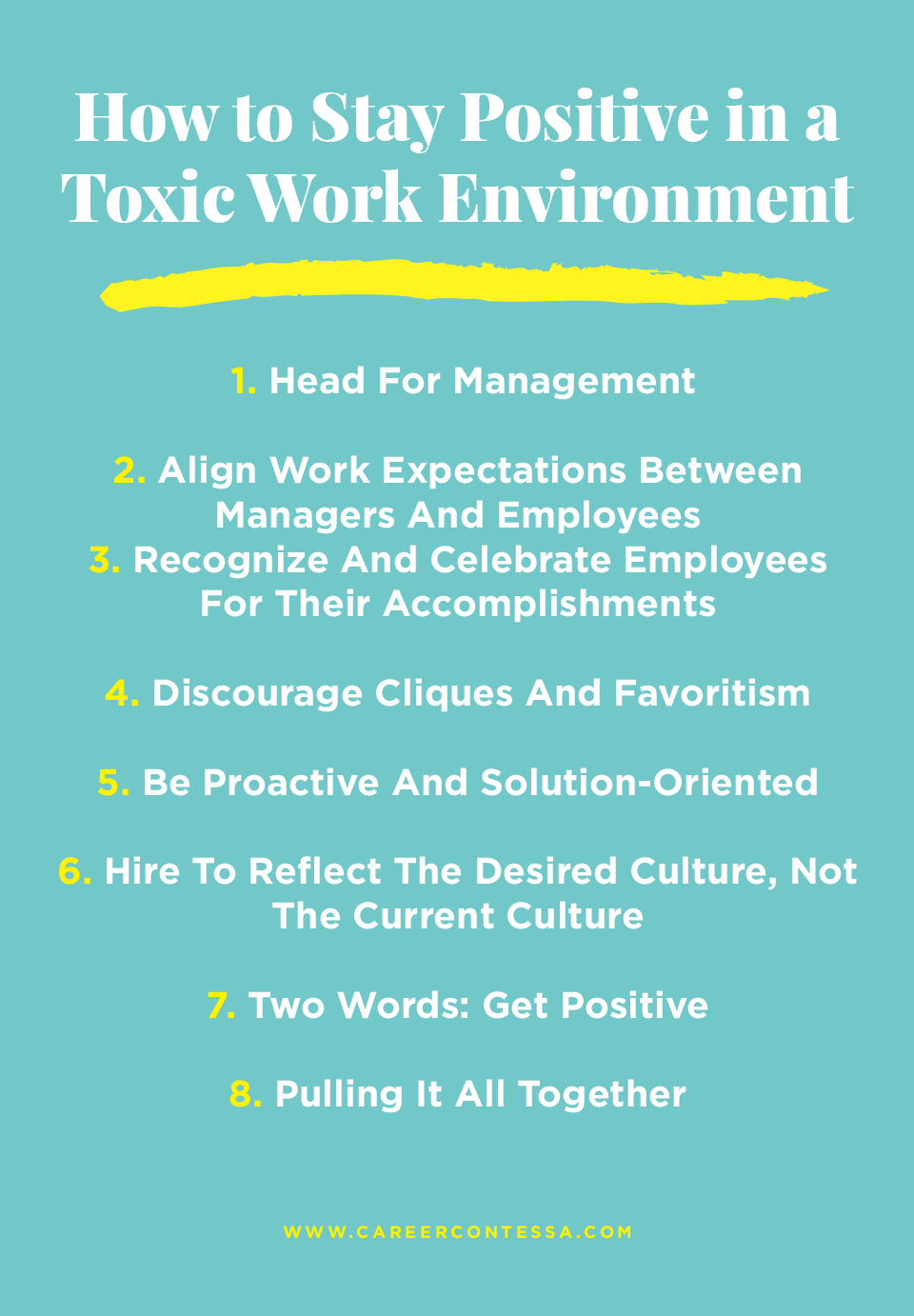How can you stay positive in a negative workplace?
You made the job search work in your favor. You updated your LinkedIn, sent out personalized, stellar cover letters with your resume, and landed an interview with one of your coveted “it” companies—check.
You killed it at said interview, scored an offer, negotiated like a boss, and accepted it while feeling like a million bucks—check, check, check, and check.
But three months later, you’ve realized that your “it” company has a
terrible company culture, and you’re completely unhappy. As it turns out,
you hate your new job. How did this happen?
When job hunting, a big piece of your homework should be to research the company's culture and be on alert for
potential red flags.
But if you find yourself facing a negative situation in the here and now, can you change the environment of your workplace for the better? Or is it just a lost cause?
Negative Workplace: What Makes A Toxic Work Environment?
Workplace problems run the gamut from unprofessional colleagues (gossiping, taking credit where credit is not due, acting aggressively negative or unfairly competitive in meetings, etc.) or terrible bosses (those who don’t have good leadership skills or those who, perhaps feeling threatened, keep you from growing) to just an unhealthy work-life balance.
It’s difficult to pinpoint all the elements that make up a bad office culture, but like many diseases, the symptoms are easier to spot than the causes.
If you’re facing a toxic work environment, you might find yourself getting sick constantly, questioning your talents and worth (often
caused by gaslighting), fighting with your S.O. more frequently, or your family and friends might have pointed out that your personality seems to have shifted.
There are countless other signs, but the point is that your health and happiness is at risk if you don’t do something about it. The most obvious option is to quit, but if this is still your dream job, despite the culture problems, you might be able to redeem the situation.
How To Stay Positive in a Bad Workplace
Our advice, when it comes to toxic or hostile work environments, is to run through some potential fixes before hitting the road. However, listen to your gut.
If you think your workplace has the potential to ditch the negative attitudes and
grow in empathy, we have advice to help you push it along!
If you just know that the workplace is unfixable, get your resume back out there!
1. Head For Management
The most important element? Senior management has to acknowledge that there is a problem and agree that change is necessary. If they don’t take that first step, they will never implement real, lasting change that improves the company morale.
HR or upper management might already be vaguely aware of the situation, so even if it’s an unwelcome wake-up call, bringing it to their attention might motivate them to take some much-needed action.
Still, if they’re completely clueless, you’re going to have to take the time to educate them via show-and-tell. Come prepared with real-life examples of what is broken and what needs work—and constructive suggestions on how they can fix it.
Regardless of whether you're a new or long-time employee, tackling such a touchy subject is a difficult but necessary evil. If you can, find colleagues willing to stand with and support you and your proposed solution(s), which will make you much more likely to be heard and addressed.
So put on your white hat, Olivia Pope style, and get ready to present proof of the issues and solutions on how to implement change.
2. Align Work Expectations Between Managers And Employees
Meaning, the whole team needs to learn to communicate more clearly, productively, and transparently (if you're in a toxic work environment, the only thing that’s transparent right now is the gossip). You’re all going to need to reset some learned bad behaviors.
By no means is this an easy task—it requires work and intention by both management and employees. Sprinkle in a smattering of different work styles and personalities and it can be quite a
challenge to communicate with all of them.
Step one: Define new expectations verbally to the whole team and record them in writing so that everyone can refer to them later on. If there are issues with inappropriate behavior in meetings (like interrupting or name-calling), your team should set rules for what’s allowed and what’s not when you all sit down. We’re not saying that you should require people to raise their hands and wait to get called on before speaking—but if that’s the only thing that works? Sure.
Companies in dire need of an overhaul might consider hiring an executive career coach/firm to counsel their team. A coach provides a neutral perspective and valuable insights on improving areas of concern. While this may prove more difficult to implement as a solution due to budgetary concerns, it can provide a worthwhile ROI to your company.
3. Recognize And Celebrate Employees For Their Accomplishments
We love to celebrate everything—from small successes to huge achievements.
While extras such as working from home, flex vacation time, and yes, raises, are always attractive rewards for a job well done, smaller gestures can also go a long way.
Simply
acknowledging achievement can boost a colleague or employee’s confidence and encourage them to take a more active role in future projects
and the company.
Managers that show genuine interest in their employees and support their development are less common than one would hope, and they’re a benefit in themselves. If you’re feeling unsupported in your company, suggest implementing a mentorship program that connects management with staff and supports employees at every level.
Everyone, from executives to entry-level, will reap the benefits of closer professional relationships—and a boost in morale.
Special events like birthday celebrations, company outings, or pizza lunches every other Friday don't hurt, either. It goes without saying that employees that feel valued are happier overall—and it shows in their performance and productivity. Why wouldn't your company strive to ensure their employees are happy and healthy?
Make celebration and recognition a habit, and watch employee motivation and inter-office goodwill skyrocket.
4. Discourage Cliques And Favoritism
Cliques are a huge problem in some workplaces. These small groups of negative people can have huge, far-reaching impacts on the workplace.
"You can't sit with us!"
Mean Girls is a cult favorite for a reason—it was relatable. Whether you identified with Cady Heron, Regina George (yikes), or one of the other infamous characters, chances are you've encountered similar personalities to all of them at one point.
I wish I could tell you that cliques and catty behaviors were left behind in the school hallways, but unfortunately, a lot of the same situations can present themselves in the office—if you allow them to.
Upper management can stop bad behavior if they treat it with a zero-tolerance policy. If not, things can easily spiral out of control. Worst-case scenarios aside, every employee deserves a safe and harassment-free working environment in which they feel included as part of the team.
5. Be Proactive And Solution-Oriented
This applies not only to the company's products and services, but to its employees as well. This attitude is a common trend among Entrepreneur’s roundup of
companies with the best cultures.
Whether they operate as a “flat organization” (
Squarespace) or a cooperative (REI) or just offer open meeting spaces for employees to come together and chat (Facebook, Zappos, Google, etc.), those organizations share a sense of ownership that allows everyone to feel confident voicing their opinions and ideas.
Schedule team meetings or better yet, a town hall forum, once per month to share ideas and be sure that the voices that matter are being heard.
Feedback is important. Providing space where employees feel safe to express and share their input has long-term benefits for the entire organization.
6. Hire To Reflect The Desired Culture, Not The Current Culture
Create a list of values, qualities, and goals that current and future employees should have, with criteria ranging from "must-haves" to "nice-to-haves”.
7. Two Words: Get Positive
The bad news is that negativity is contagious. The good news? A positive mindset is also infectious!
Lead by example. You can't expect change to happen if you don’t step up. Positive people beget positivity, so try to lead with a positive outlook. And, no, you don't need to hold a management position to instill mood-changing optimism at work.
Take time to get to know your colleagues (especially the ones you aren't drawn to naturally), be kind always, and generally be your awesome, super cool self. Bonus points: management will likely take notice and appreciate you for the effort.
8. Pulling It All Together
The culture of a workplace is another product of the company. You take pride in your job, as do your coworkers—it would be a shame to allow toxicity to ruin an otherwise ideal opportunity. Working together to improve the situation can drastically change your outlook and overall job satisfaction. Given that the average person spends over
90,000 hours at work over their lifetime, that’s no small issue.
Consider these steps your extinguisher for putting out the fire at your company. But remember that office toxicity is sneaky—without concentrated effort and unflagging desire for change, a company can easily become stagnant and revert to the status quo.
As a smart, seasoned professional, it’s your responsibility to recognize when it's worthwhile to lend your effort to creating change and when it's time to move on for a better overall fit. Your career and happiness are non-negotiable.












